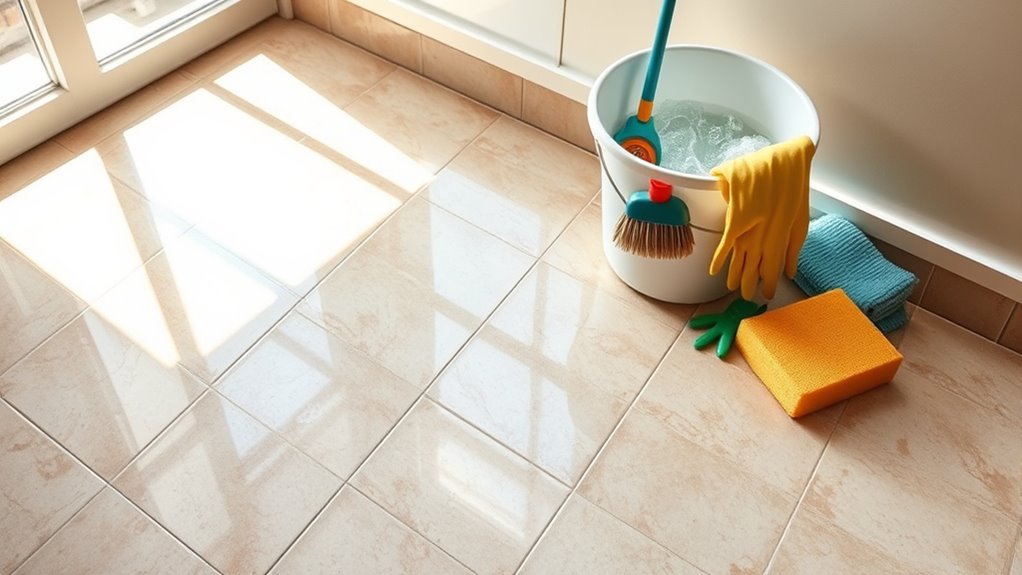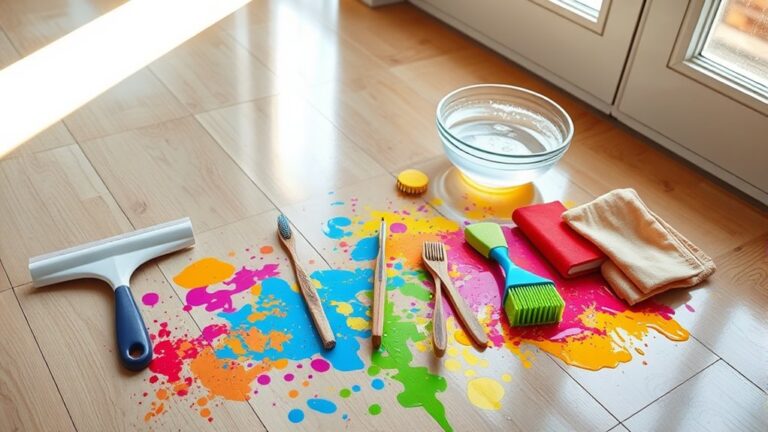To clean old linoleum floors, start by gathering soft brooms, microfiber cloths, and a gentle cleaner safe for linoleum. Remove loose dirt with a broom or vacuum set for hard floors. Mix warm water with mild soap and a splash of vinegar, then mop carefully without soaking. Tackle stains with baking soda or rubbing alcohol based on the type. Rinse and dry thoroughly to avoid water damage. Finish by applying a protective sealant compatible with your sol. Discover each step in detail to keep your floor looking great.
Rassemblez vos fournitures de nettoyage
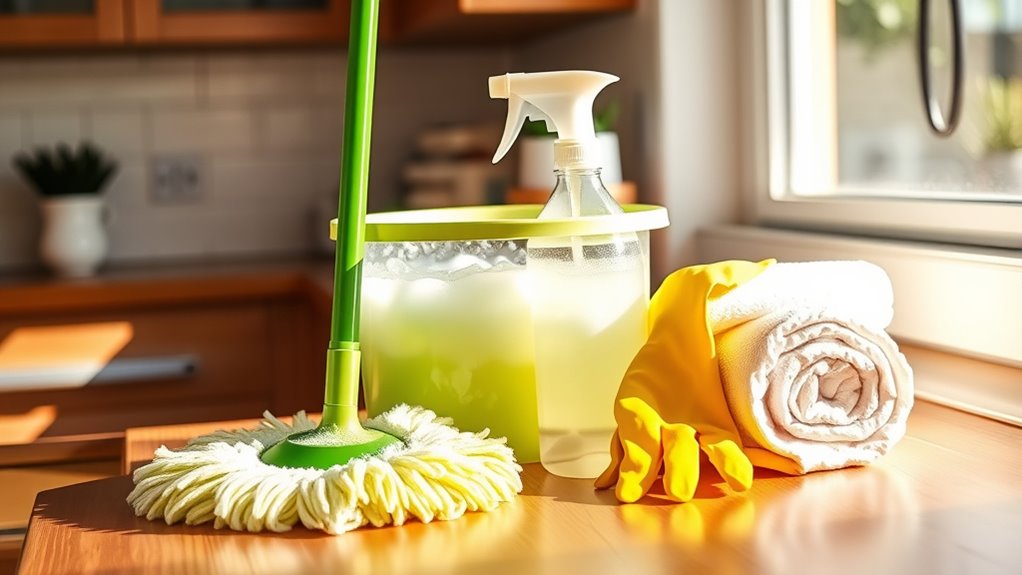
To effectively clean old linoleum floors, you’ll need five essential supplies: a broom or vacuum, a mop, a bucket, a gentle cleaner, and microfiber cloths. Start by selecting cleaning tools designed to protect delicate surfaces—avoid harsh brushes or abrasive pads. Your mop should be soft to prevent scratches, and your bucket should be large enough to hold sufficient water for rinsing. Choose cleaning products labeled safe for linoleum; harsh chemicals can damage its finish and reduce your freedom to enjoy a spotless floor without worry. Microfiber cloths are vital for drying and spot-cleaning, thanks to their absorbency and lint-free nature. Gathering these specific cleaning tools and products guarantees a smooth, efficient process, giving you control and confidence in restoring your floor’s original shine.
Remove Loose Dirt and Debris
Before you mop, you’ll need to remove any loose dirt and debris from your linoleum floor. Start by sweeping with a soft-bristle broom, using smooth, deliberate strokes. Focus on corners and edges where dust tends to accumulate. Effective sweeping techniques help prevent scratching during cleaning. Next, use a vacuum designed for hard floors to pick up finer particles. When vacuuming, avoid using a beater bar to protect your floor’s surface. Vacuuming tips include setting the suction to a moderate level and moving methodically across the floor to cover every inch. Removing loose dirt thoroughly not only prevents grit from scratching your linoleum but also guarantees your cleaning solution works more effectively. Taking these steps grants you the freedom to maintain your floor’s appearance with minimal effort.
Prepare a Gentle Cleaning Solution
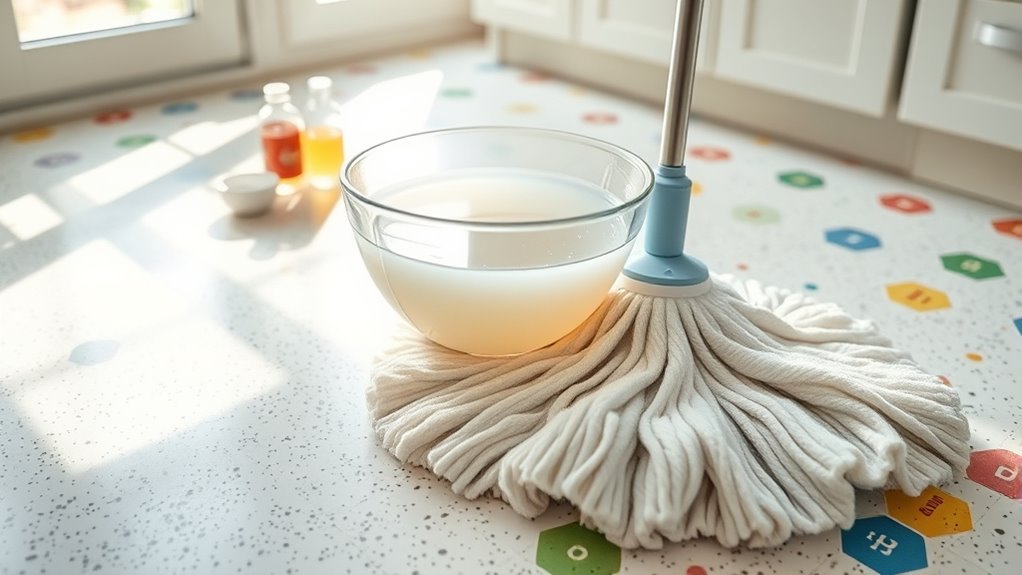
Since harsh chemicals can damage old linoleum, you’ll want to prepare a gentle cleaning solution that effectively lifts dirt without causing wear. Opt for gentle ingredients that protect the floor’s finish while being kind to the environment. Eco friendly options not only safeguard your linoleum but also support a healthier living space. Here’s a simple guide to creating your solution:
Choose gentle, eco-friendly cleaners to protect old linoleum and maintain a healthy, damage-free floor finish.
- Mix warm water with a few drops of mild dish soap
- Add a splash of white vinegar for natural disinfecting power
- Avoid bleach or ammonia, which can damage linoleum
- Consider castile soap as a plant-based alternative
- Test the solution on a small area before full application
This approach guarantees your floors stay clean and intact, letting you enjoy freedom from harsh chemicals.
Mop the Floor Thoroughly
You’ll want to select a cleaning solution that’s gentle yet effective for old linoleum. Make sure to wring out your mop well to avoid excess water, which can damage the floor. Use steady, overlapping strokes to cover the entire surface evenly.
Choose Proper Cleaning Solution
Selecting an effective cleaning solution is key to restoring your old linoleum floor without causing damage. You’ll want a product that respects the floor’s integrity and promotes longevity. Focus on solutions with a neutral pH balance to prevent wear or discoloration. Eco friendly options not only protect your floor but also keep your space healthier.
Consider these points when choosing your cleaner:
- Use a pH-neutral or mildly alkaline solution
- Opt for biodegradable, non-toxic ingredients
- Avoid harsh chemicals like bleach or ammonia
- Test the cleaner in a small hidden area first
- Make sure the product is safe for vintage or delicate linoleum
Choosing the right cleaner empowers you to maintain your floor’s charm while enjoying freedom from harsh chemicals.
Use Correct Mopping Technique
Although choosing the right cleaner is essential, using the correct mopping technique guarantees your old linoleum floor gets a thorough, even clean. Start by selecting a mop type that suits your floor’s condition—microfiber mops work well for gentle yet effective cleaning. Mop in sections, using a figure-eight motion to avoid streaks. Pay attention to mopping frequency; regular cleaning prevents buildup and maintains freedom from grime.
| Type de balai | Meilleure utilisation |
|---|---|
| Microfiber | Delicate, everyday use |
| Balai éponge | Heavier stains |
| Balai à franges | Grandes surfaces |
| Flat Mop | Quick, light cleaning |
| Steam Mop | Deep cleaning, no chemicals |
Stick to a schedule that balances your lifestyle and floor needs—weekly or biweekly mopping keeps your linoleum fresh without hassle.
Tackle Stubborn Stains
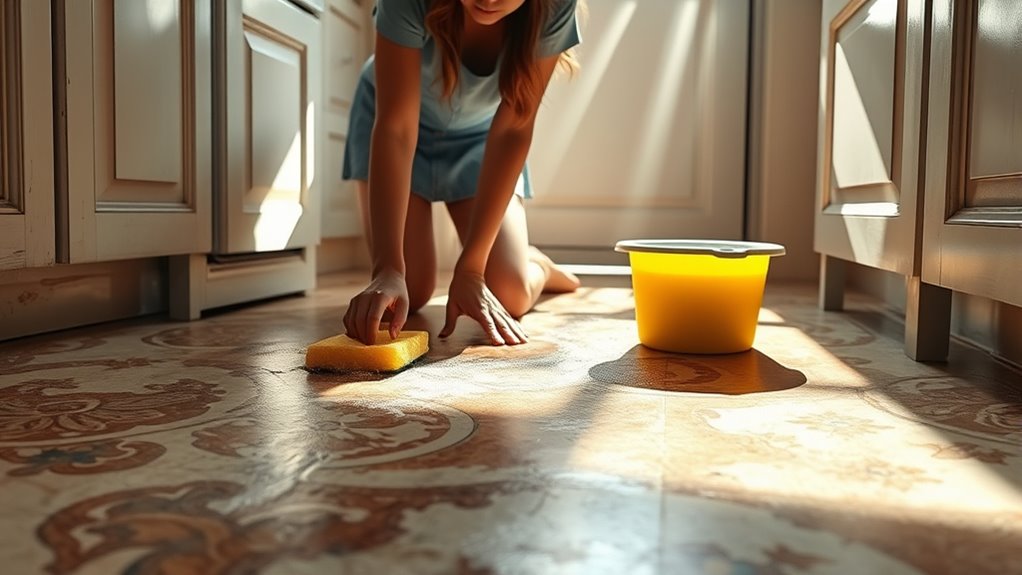
When stains refuse to lift with basic cleaning, it’s crucial to apply targeted methods to restore your linoleum’s appearance. Mastering stain removal techniques helps you conquer common stubborn stains without damaging the floor. Start by identifying the stain type, then choose the right approach:
Effective stain removal begins with identifying the stain type and using targeted methods to protect your linoleum floor.
- Use a mixture of baking soda and water for grease and oil stains.
- Apply white vinegar to tackle ink or marker marks.
- Try rubbing alcohol on stubborn scuff marks.
- Employ a gentle commercial linoleum cleaner for dye-based stains.
- For rust stains, use lemon juice or a rust remover designed for floors.
Rinse and Dry the Floor
Once you’ve removed the stains, it’s essential to rinse the floor thoroughly to eliminate any cleaning residue. Use clean water and a damp mop, changing the water frequently to avoid spreading dirt. After rinsing, dry the floor completely with a microfiber cloth or towel to prevent water spots and maintain the linoleum’s finish.
Proper Rinsing Techniques
Before you finish cleaning, you’ll need to rinse the linoleum floor thoroughly to remove any soap residue. Using the right rinsing methods guarantees your floor stays spotless without damage. Opt for lukewarm water—it’s the perfect water temperature to loosen soap without harming the linoleum’s surface. Avoid hot water, which could warp or discolor the floor.
Here’s how to rinse properly:
- Use a mop or sponge dampened in clean, lukewarm water
- Change rinse water frequently to avoid spreading dirt
- Rinse in sections to manage water use and drying
- Gently scrub stubborn soap spots with a soft cloth
- Avoid excessive water pooling, which can seep into seams
This methodical approach assures a clean, soap-free floor, prepping it for the final drying stage.
Effective Drying Methods
Although rinsing removes most residue, you’ll need to dry the linoleum floor thoroughly to prevent water damage and streaks. Start by using a clean, absorbent microfiber mop or towel to soak up excess water immediately after rinsing. This step reduces drying time and minimizes the risk of water seeping into seams or edges. Next, employ air drying techniques to speed up evaporation. Open windows and doors to create cross-ventilation, allowing fresh air to circulate freely. For faster results, position a fan to blow across the floor’s surface. Fan usage promotes airflow, helping moisture evaporate evenly and preventing damp spots. Avoid walking on the floor until it’s completely dry to maintain the finish and avoid dirt deposits. Following these steps guarantees your linoleum stays protected and looks its best.
Appliquer une finition protectrice
A protective finish is essential to preserve the cleanliness and durability of your old linoleum floors. Applying the right protective coatings simplifies floor maintenance and extends the life of your flooring. Begin by selecting a finish compatible with linoleum, like a water-based polyurethane or acrylic sealer. Clean and dry the floor thoroughly before application. Use a microfiber mop or applicator pad for even coverage, working in small sections. Allow sufficient drying time between coats.
Protect your old linoleum floors with a compatible finish for easy maintenance and long-lasting durability.
Keep in mind these tips:
- Test finish on a small area first
- Apply thin, even layers
- Avoid heavy foot traffic until fully cured
- Reapply every 1-2 years for ideal protection
- Store unused coatings properly to maintain effectiveness

